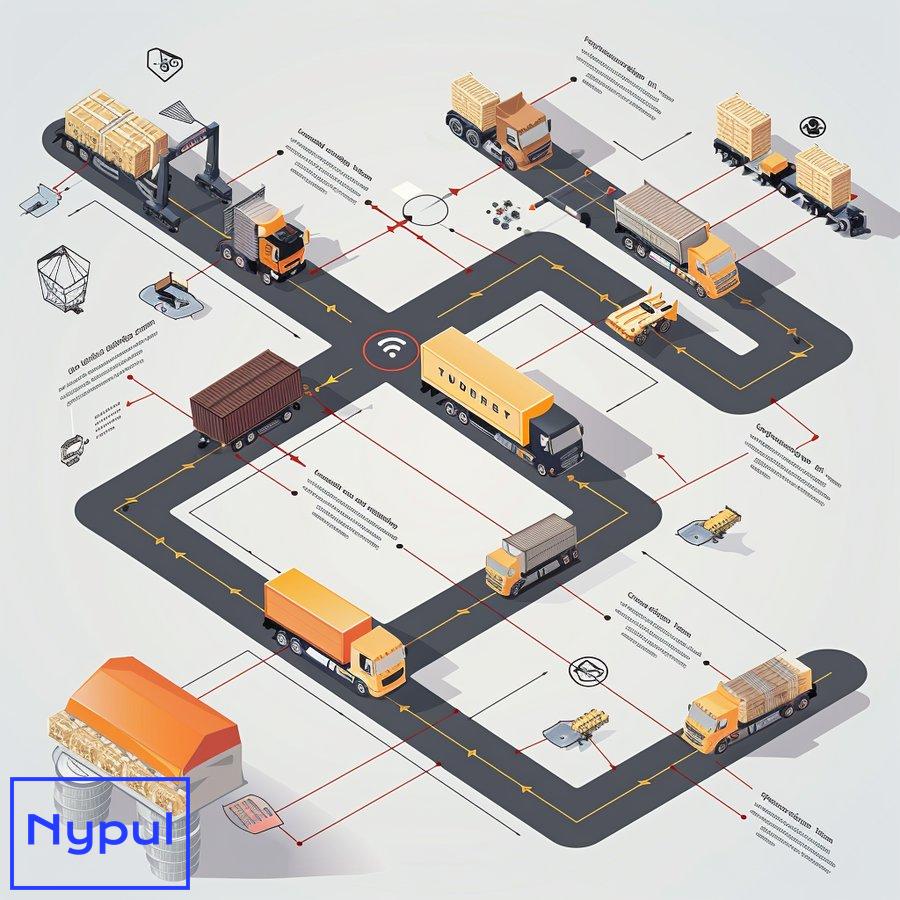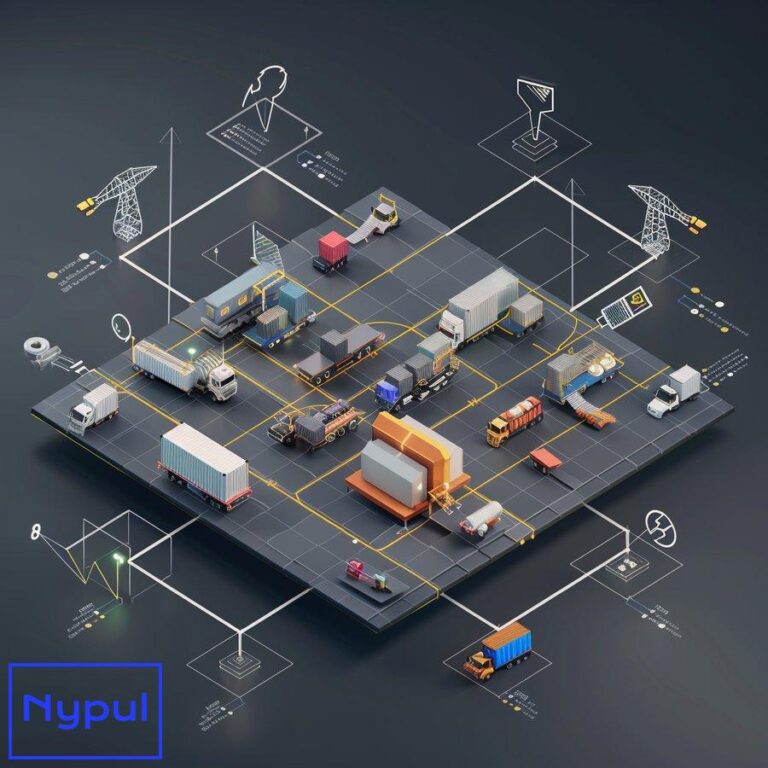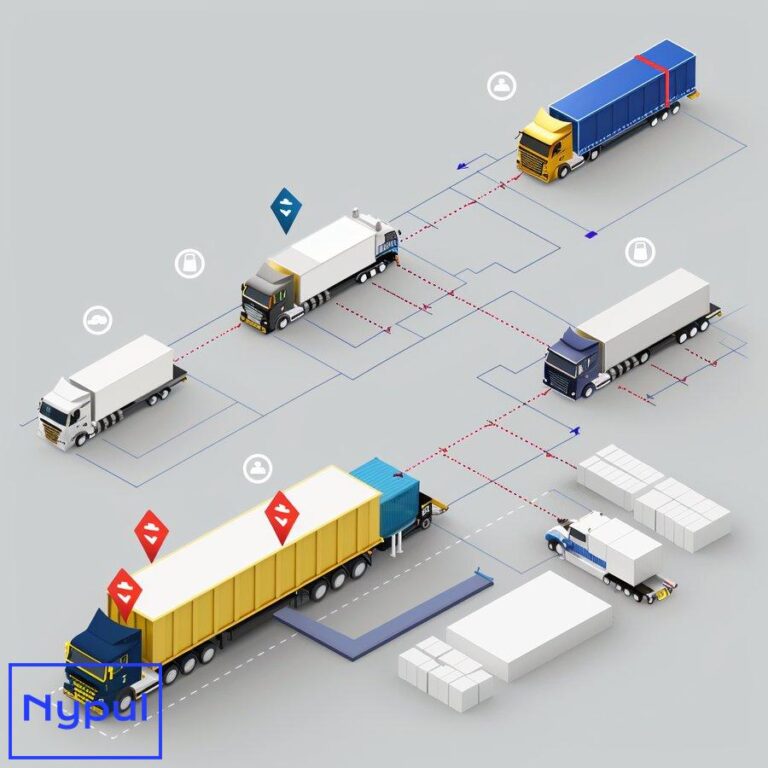How to Reduce the Carbon Footprint of Transport
What are the major sources of emissions in logistics and drayage?
The logistics and drayage industry plays a crucial role in global trade and commerce, but it also contributes significantly to greenhouse gas emissions. Understanding the primary sources of these emissions is essential for developing effective strategies to reduce the carbon footprint of transport operations.
Road Transport

Road transport, including trucks and vans, is the largest contributor to emissions in the logistics sector. Heavy-duty trucks, used for long-haul transportation and drayage operations, are responsible for a substantial portion of these emissions. The combustion of diesel fuel in these vehicles releases carbon dioxide (CO2), nitrogen oxides (NOx), and particulate matter into the atmosphere.
Maritime Shipping
Ocean freight, while efficient for large-scale transportation, is another significant source of emissions. Container ships and bulk carriers rely heavily on heavy fuel oil, which produces high levels of CO2, sulfur oxides (SOx), and NOx when burned. The international nature of maritime shipping makes it challenging to regulate and monitor emissions effectively.
Air Freight
Although air freight accounts for a smaller volume of goods transported compared to road and sea, it has a disproportionately high impact on emissions. Aircraft emit CO2 at high altitudes, where the greenhouse effect is more pronounced. The rapid growth of e-commerce and demand for fast deliveries has increased the use of air freight, exacerbating its environmental impact.
Warehousing and Distribution Centers
While often overlooked, warehouses and distribution centers contribute to the overall carbon footprint of logistics operations. Energy consumption for lighting, heating, cooling, and operating material handling equipment generates indirect emissions. The increasing automation and use of robotics in these facilities can lead to higher energy demands if not managed efficiently.
Last-Mile Delivery
The final leg of the supply chain, known as last-mile delivery, has become a significant source of emissions in urban areas. The proliferation of e-commerce has led to a surge in small package deliveries, often using less efficient vehicles for multiple stops. This fragmentation of deliveries contributes to increased traffic congestion and emissions in densely populated areas.
Refrigerated Transport
Refrigerated transport, or “reefer” logistics, is essential for perishable goods but comes with a higher environmental cost. The energy required to maintain low temperatures in refrigerated trucks, containers, and warehouses adds to the overall emissions of the cold chain logistics sector.
To illustrate the relative contribution of different transport modes to emissions, consider the following table:
| Transport Mode | CO2 Emissions (g/tonne-km) |
|---|---|
| Road (Truck) | 62-110 |
| Rail | 22-63 |
| Maritime | 10-40 |
| Air Freight | 435-1,800 |
This table highlights the significant differences in emissions intensity across various transport modes, with air freight having the highest emissions per tonne-kilometer transported.
Understanding these major sources of emissions is the first step in developing targeted strategies to reduce the carbon footprint of logistics and drayage operations. By focusing on these key areas, companies can prioritize their efforts and investments in sustainable practices and technologies to achieve meaningful reductions in greenhouse gas emissions.
How can upgrading to fuel-efficient vehicles reduce carbon footprint?

Upgrading to fuel-efficient vehicles is a powerful strategy for reducing the carbon footprint of transport operations. This approach not only decreases greenhouse gas emissions but also offers long-term cost savings and improved operational efficiency.
Advanced Engine Technologies
Modern fuel-efficient vehicles incorporate advanced engine technologies that optimize combustion processes and reduce fuel consumption. Turbocharging, direct fuel injection, and variable valve timing are examples of innovations that enhance engine performance while minimizing emissions. These technologies allow engines to produce more power with less fuel, resulting in lower CO2 emissions per mile traveled.
Aerodynamic Design
Fuel-efficient vehicles often feature aerodynamic designs that reduce air resistance, particularly important for long-haul trucks. Streamlined cab shapes, side skirts, and rear fairings can significantly decrease drag, allowing vehicles to maintain speed with less engine effort. For example, a well-designed aerodynamic package can improve fuel efficiency by up to 15% for heavy-duty trucks operating at highway speeds.
Lightweight Materials
The use of lightweight materials in vehicle construction, such as high-strength steel, aluminum, and composites, reduces overall vehicle weight. This weight reduction directly translates to improved fuel efficiency, as less energy is required to move the vehicle. For every 10% reduction in vehicle weight, fuel consumption can decrease by approximately 5-7%.
Tire Technology
Advanced tire technologies play a crucial role in fuel efficiency. Low rolling resistance tires reduce the energy required to move the vehicle, leading to fuel savings and lower emissions. Proper tire inflation and regular maintenance are equally important, as underinflated tires can increase fuel consumption by up to 3%.
Hybrid and Electric Powertrains
Hybrid and electric vehicles represent a significant leap in fuel efficiency and emissions reduction. Hybrid powertrains combine internal combustion engines with electric motors, optimizing fuel use and recovering energy through regenerative braking. Fully electric vehicles produce zero tailpipe emissions and can be particularly effective in reducing the carbon footprint of urban delivery operations.
Transmission Improvements
Advanced transmission systems, such as automated manual transmissions (AMTs) and continuously variable transmissions (CVTs), optimize gear ratios for different driving conditions. These systems ensure that the engine operates at its most efficient speed, reducing fuel consumption and emissions. AMTs can improve fuel efficiency by 2-5% compared to traditional manual transmissions.
Driver Assistance Systems
Modern fuel-efficient vehicles often include driver assistance systems that promote eco-driving practices. Features such as adaptive cruise control, predictive cruise control, and real-time fuel efficiency feedback help drivers maintain optimal speeds and driving patterns, further reducing fuel consumption and emissions.
To illustrate the potential impact of upgrading to fuel-efficient vehicles, consider the following comparison table:
| Vehicle Type | Fuel Efficiency (mpg) | Annual CO2 Emissions (tons) | Fuel Cost Savings (%) |
|---|---|---|---|
| Traditional Diesel Truck | 6.5 | 201 | – |
| Modern Fuel-Efficient Truck | 8.5 | 154 | 23% |
| Hybrid Electric Truck | 10.5 | 124 | 38% |
| Full Electric Truck | N/A (kWh/mile) | 0 (tailpipe) | Up to 60% |
This table demonstrates the significant reductions in CO2 emissions and potential fuel cost savings achievable through upgrades to more fuel-efficient vehicles.
Implementation Strategies
Implementing a fleet upgrade strategy requires careful planning and consideration of operational needs. A phased approach, starting with replacing the oldest and least efficient vehicles, can help manage costs and allow for the integration of new technologies over time. Fleet managers should also consider:
Total Cost of Ownership: While fuel-efficient vehicles may have higher upfront costs, the long-term savings in fuel and maintenance often result in a lower total cost of ownership.
Route Optimization: Pairing fuel-efficient vehicles with optimized routes can maximize the benefits of the upgrade, further reducing emissions and operational costs.
Driver Training: Providing training on eco-driving techniques ensures that the full potential of fuel-efficient vehicles is realized through proper operation.
Maintenance Programs: Regular maintenance is crucial for maintaining the efficiency of advanced vehicle technologies. Implementing robust maintenance programs helps preserve fuel efficiency and extend vehicle lifespan.
Upgrading to fuel-efficient vehicles is a tangible and effective way for logistics and drayage companies to reduce their carbon footprint. The combination of advanced technologies, improved designs, and alternative powertrains offers significant potential for emissions reduction and operational cost savings. As regulations tighten and stakeholders demand more sustainable practices, investing in fuel-efficient vehicles becomes not just an environmental choice but a strategic business decision for long-term success in the transport industry.
What are the benefits of alternative fuels and technologies in sustainable transport?
The adoption of alternative fuels and technologies in the transport sector offers a range of benefits that contribute to sustainability goals and operational efficiency. These innovations provide solutions to reduce greenhouse gas emissions, improve air quality, and decrease dependence on fossil fuels.

Reduced Greenhouse Gas Emissions
Alternative fuels and technologies significantly lower greenhouse gas emissions compared to conventional fossil fuels. For example, biodiesel produced from waste vegetable oils can reduce lifecycle CO2 emissions by up to 86% compared to petroleum diesel. Similarly, electric vehicles powered by renewable energy sources can achieve near-zero emissions, dramatically reducing the carbon footprint of transport operations.
Improved Air Quality
Many alternative fuels produce fewer pollutants such as particulate matter, nitrogen oxides, and sulfur oxides. This reduction in harmful emissions leads to improved air quality, particularly in urban areas where transport-related pollution is a major concern. For instance, natural gas vehicles emit up to 90% less carbon monoxide and 25% less carbon dioxide than gasoline vehicles.
Energy Security and Diversification
Adopting alternative fuels reduces dependence on imported petroleum, enhancing energy security. Diversifying the energy sources used in transport makes the sector more resilient to supply disruptions and price fluctuations in the global oil market. This diversification can lead to more stable and predictable operational costs for transport companies.
Economic Benefits
The development and adoption of alternative fuels and technologies create new economic opportunities. This includes job creation in research, manufacturing, and infrastructure development. For example, the electric vehicle industry has become a significant source of employment and economic growth in many regions.
Noise Reduction
Some alternative technologies, particularly electric and hydrogen fuel cell vehicles, operate much more quietly than conventional internal combustion engines. This noise reduction is especially beneficial in urban environments and for night-time deliveries, potentially allowing for extended operating hours and improved efficiency.
Renewable and Sustainable Sources
Many alternative fuels can be produced from renewable sources, such as biomass, solar, and wind energy. This renewable nature ensures a more sustainable long-term energy supply for the transport sector, reducing the environmental impact of fuel production and use.
To illustrate the comparative benefits of various alternative fuels and technologies, consider the following table:
| Fuel/Technology | CO2 Reduction (%) | Air Quality Improvement | Energy Security | Noise Reduction |
|---|---|---|---|---|
| Biodiesel | 50-86 | High | Medium | Low |
| Natural Gas | 20-30 | High | Medium | Medium |
| Electric | Up to 100* | Very High | High | Very High |
| Hydrogen | Up to 100* | Very High | High | Very High |
| Ethanol | 30-50 | Medium | High | Low |
*When powered by renewable energy sources.
Specific Benefits of Key Alternative Fuels and Technologies
Biodiesel
Biodiesel, derived from vegetable oils or animal fats, offers a renewable alternative to petroleum diesel. It can be used in existing diesel engines with little or no modification, making it a practical option for immediate adoption. Biodiesel also provides improved lubricity, which can extend engine life and reduce maintenance costs.
Natural Gas
Compressed Natural Gas (CNG) and Liquefied Natural Gas (LNG) vehicles offer significant reductions in particulate matter and NOx emissions. Natural gas is abundant in many regions, providing a cost-effective alternative to diesel, particularly for heavy-duty vehicles and long-haul transport.
Electric Vehicles
Electric vehicles (EVs) offer zero tailpipe emissions and high energy efficiency. The advancement in battery technology has increased the range and reduced charging times, making EVs increasingly viable for various transport applications, from last-mile delivery to short-haul trucking. The total cost of ownership for EVs is becoming competitive with conventional vehicles, especially in regions with supportive policies and infrastructure.
Hydrogen Fuel Cells
Hydrogen fuel cell vehicles combine the zero-emission benefits of electric vehicles with the quick refueling times of conventional vehicles. They are particularly promising for long-haul transport and heavy-duty applications where battery weight and charging times may be limiting factors for pure electric solutions.
Challenges and Considerations
While alternative fuels and technologies offer numerous benefits, their adoption also comes with challenges:
Infrastructure Development: The widespread adoption of alternative fuels requires significant investment in refueling or charging infrastructure.
Initial Costs: Alternative fuel vehicles often have higher upfront costs, although this can be offset by lower operating costs over time.
Technology Maturity: Some alternative technologies are still evolving, which may lead to concerns about reliability and performance in certain applications.
Policy Support: The success of alternative fuels often depends on supportive government policies, including incentives and regulations.
The benefits of alternative fuels and technologies in sustainable transport are substantial and multifaceted. From reducing greenhouse gas emissions and improving air quality to enhancing energy security and creating economic opportunities, these innovations offer a path towards a more sustainable and efficient transport sector. As technology advances and infrastructure develops, the adoption of alternative fuels and technologies is likely to accelerate, playing a crucial role in reducing the carbon footprint of logistics and drayage operations.
How can route optimization and load consolidation improve efficiency?

Route optimization and load consolidation are powerful strategies that can significantly enhance the efficiency of logistics operations while reducing the carbon footprint of transport. These approaches focus on maximizing the utilization of vehicles and minimizing unnecessary travel, resulting in reduced fuel consumption, lower emissions, and improved operational performance.
Route Optimization
Route optimization involves using advanced algorithms and data analysis to determine the most efficient paths for vehicles to take when making deliveries or pickups. This process considers various factors such as distance, traffic patterns, delivery time windows, and vehicle capacities to create the most effective routes.
Reduced Mileage: Optimized routes minimize the total distance traveled, directly reducing fuel consumption and emissions. Studies have shown that effective route optimization can reduce total mileage by 10-30%.
Time Efficiency: By avoiding traffic congestion and minimizing idle time, route optimization helps vehicles complete their journeys more quickly, allowing for more deliveries per day and reducing overall fleet size requirements.
Improved Vehicle Utilization: Efficient routing ensures that vehicles are used to their full capacity, reducing the number of vehicles needed on the road and maximizing the productivity of each trip.
Real-time Adjustments: Advanced route optimization systems can adapt to real-time conditions, such as traffic incidents or last-minute order changes, ensuring continued efficiency even in dynamic environments.
Load Consolidation
Load consolidation involves combining multiple shipments or orders into fewer, fuller loads. This strategy maximizes the use of available cargo space and reduces the number of trips required to transport goods.
Reduced Number of Trips: By consolidating loads, fewer vehicles are needed to transport the same volume of goods, leading to significant reductions in fuel consumption and emissions.
Improved Vehicle Fill Rates: Load consolidation increases the average fill rate of vehicles, ensuring that cargo space is used more efficiently. This can lead to a reduction in the total number of vehicles required in a fleet.
Cost Savings: Fewer trips mean lower fuel costs, reduced wear and tear on vehicles, and potentially lower labor costs, contributing to overall operational savings.
Enhanced Supply Chain Visibility: The process of consolidating loads often requires better coordination and communication among supply chain partners, leading to improved visibility and planning across the entire logistics network.
To illustrate the potential impact of route optimization and load consolidation, consider the following table:
| Strategy | Fuel Savings (%) | CO2 Reduction (%) | Trip Reduction (%) | Cost Savings (%) |
|---|---|---|---|---|
| Route Optimization | 10-30 | 10-30 | 5-15 | 15-35 |
| Load Consolidation | 20-40 | 20-40 | 30-50 | 25-45 |
| Combined Approach | 30-60 | 30-60 | 35-60 | 40-70 |
This table demonstrates the significant potential for improvement when implementing these strategies, either individually or in combination.
Implementation Strategies
Implementing effective route optimization and load consolidation requires a systematic approach and the right tools:
Advanced Software Solutions: Utilize sophisticated transportation management systems (TMS) and route optimization software that can handle complex variables and constraints.
Data Integration: Integrate data from various sources, including GPS tracking, traffic information, weather forecasts, and historical performance data, to inform decision-making.
Cross-docking: Implement cross-docking facilities where goods from multiple sources can be consolidated into full truckloads without the need for long-term storage.
Collaborative Shipping: Partner with other companies or use third-party logistics providers to combine shipments going to similar destinations.
Dynamic Scheduling: Implement flexible scheduling systems that can adapt to changing demand patterns and optimize load consolidation opportunities.
Key Benefits
Reduced Carbon Footprint: The primary environmental benefit of these strategies is the significant reduction in greenhouse gas emissions due to fewer vehicle miles traveled and more efficient use of transport resources.
Improved Customer Service: Optimized routes and consolidated loads can lead to more reliable delivery times and increased flexibility in meeting customer needs.






